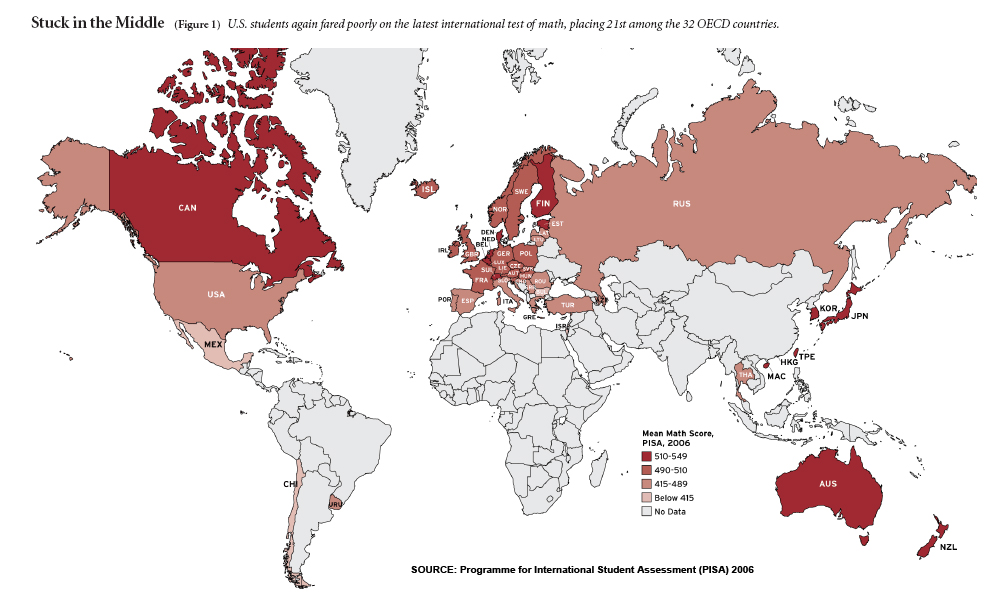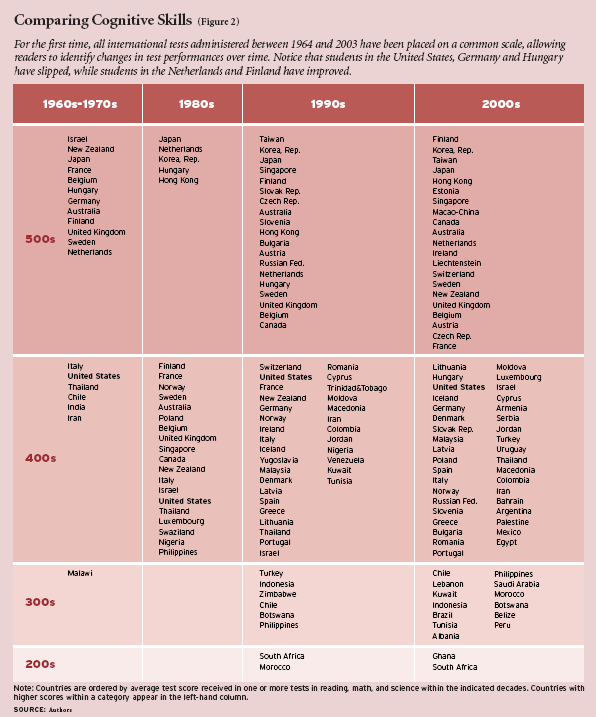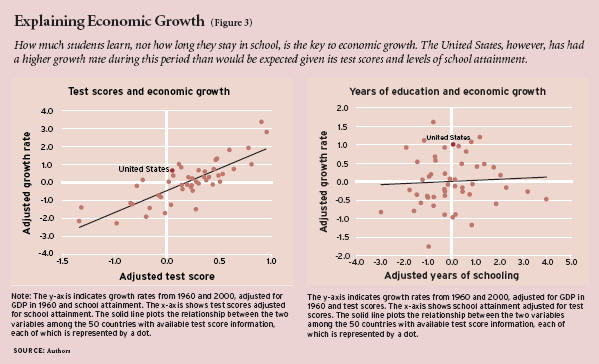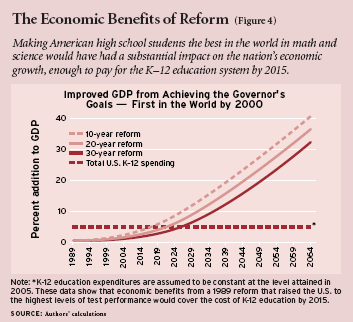Even before and certainly ever since the 1983 release of A Nation at Risk by the National Commission on Excellence in Education, national economic competitiveness has been offered as a primary reason for pushing school reform. The commission warned, “If only to keep and improve on the slim competitive edge we still retain in world markets, we must dedicate ourselves to the reform of our educational system for the benefit of all—old and young alike, affluent and poor, majority and minority.” Responding to these urgent words, the National Governors Association, in 1989, pledged that U.S. students would lead the world in math and science achievement by 2000.
According to the latest international math and science assessment conducted by the Organisation of Economic Co-operation and Development’s (OECD) Programme for International Student Assessment (PISA) (see Figure 1), the United States remains a long distance from that target. Rather than worrying about the consequences, some have begun to question what all the fuss was about. Education researcher Gerald Bracey, for example, has argued that no one has “provided any data on the relationship between the economy’s health and the performance of schools. Our long economic boom suggests there isn’t one—or that our schools are better than the critics claim.”
Truth be told, the Bracey critique is not entirely misplaced. Most commentators rely more on the commonsense understanding that countries must have good schools to succeed economically rather than presenting conclusive empirical evidence that connects what students learn in school to what subsequently happens in a nation’s economy. Even economists, the people who think the most systematically about the way in which “human capital” affects a nation’s economic future, have skirted the heart of the question by looking only at “school attainment,” namely the average number of years students remain in school.
Using average years of schooling as an indicator of a country’s human capital has at least two major drawbacks. First and foremost, the approach assumes that students in diverse school systems around the world receive the same educational benefits from a year of schooling. A year of schooling in Papua New Guinea and a year of schooling in Japan are treated as equally productive. Second, this measure does not account for learning that takes place outside the classroom—within families, among peers, or via the Internet, for example.
A more direct measure of a country’s human capital is the performance of students on tests in math and science, something that might be called the average level of “cognitive skills” among those entering a country’s work force. At one time, internationally comparable information on student performance was not available for a sufficient number of countries over a long enough period of time to allow for systematic study, which is why economists relied upon the less informative measures of school attainment. Now that test-score data for many countries over an extended period of time are readily available, it is possible to supplement measures of educational attainment with these more direct measures of cognitive skills.
In a series of studies conducted over several years, the four of us have explored the role of both school attainment and cognitive skills in economic growth. Beginning in the mid-1960s, international agencies started conducting tests of students’ performance in mathematics and science at various grade levels. We used performance on 12 of these standardized tests as rough measures of the average level of cognitive skill in a given country. With this information, we could assess how human capital relates to differences in economic growth for 50 countries from 1960 to 2000, more countries over a longer period of time than any previous study. We were also able to pay close attention to institutional factors that influence economic growth, such as openness of the economy and protection of property rights.
What we discovered gives credence to the concerns expressed in A Nation at Risk. The level of cognitive skills of a nation’s students has a large effect on its subsequent economic growth rate. Increasing the average number of years of schooling attained by the labor force boosts the economy only when increased levels of school attainment also boost cognitive skills. In other words, it is not enough simply to spend more time in school; something has to be learned there.
We also discovered that the size of the impact of cognitive skills depends on whether a nation’s economy is open to outside trade and other external influences. The more open the economy, the more important it is that a country’s students are acquiring high levels of cognitive skills. As the world becomes increasingly interdependent or “flat,” to use New York Times columnist Thomas Friedman’s familiar terminology, enhancing human capital will become increasingly critical. As the world continues to change, the United States can ill afford to rest easily on its past accomplishments.
Measuring Cognitive Skills
Reaching these conclusions required a multistep analysis. The first step was to use the 12 PISA and other international math and science assessments, dating back to 1964, to construct an index of cognitive skill levels for a large sample of countries at various points in time. Because the number of countries participating in the 12 test administrations changed from one administration to the next, and because testing agencies have made no attempt to link their results to one another, we needed to develop comparable scores for each test. This required a norm against which each test could be calibrated. Fortunately, we could construct that norm by using information from tests in the United States, the country that has had the earliest, most sophisticated, and most comprehensive system of testing. The United States has participated in all of the international tests since 1964, and it has also maintained a separate longitudinal testing system of its own, the National Assessment of Educational Progress (NAEP). With that information in hand, it was possible to calibrate scores on each of the separate international tests to one another via the connection of those tests to the NAEP. To obtain further precision, we used the variation in scores across a subset of the more-advanced developed countries to obtain an estimate of the spread in scores across countries. By following these two steps, we were able to aggregate all available scores for each country into measures of average cognitive skill levels for each country.
The 50 countries for which we were able to develop a comparable measure of cognitive skill levels include the 30 democracies that have market economies and have been accepted as members of the OECD, most of which are at a relatively high level of economic development. The other 20 countries are at lower levels of economic development. In Figure 2, you can identify top performers like Finland and Japan, average performers such as the United States and Germany, and low performers that include Albania, the Philippines, and South Africa.
Impact on Economic Growth
We wanted to use this new information to compare the economic benefits of higher levels of just school attainment with the benefits of higher levels of cognitive skills. We therefore took measures of average educational attainment and average cognitive skill levels for as many countries as possible and examined their relationship to the average annual growth rate in the country’s gross domestic product (GDP) per capita from 1960 through 2000.
First, we looked just at the impact of average school attainment on the economic growth rate. (An adjustment was made for the initial level of GDP because it is “easier” to grow if you are starting out at a lower level; that is, it is easier to copy more productive technologies than to initiate progress on your own.) When we performed this analysis, we found, as other economists before us, that when the average number of years of schooling in a country was higher, the economy grew at a higher annual rate over subsequent decades. Specifically, we found that, across the 50 countries, each additional year of average schooling in a country increased the average 40-year growth rate in GDP by about 0.37 percentage points.
That may not seem like much, but consider the fact that since World War II, the world economic growth rate has been around 2 to 3 percent of GDP annually. Lifting it by 0.37 percentage points is a boost to annual growth rates of more than 10 percent of what would otherwise have occurred, a significant amount.
But the impact of improved cognitive skills, as measured by the performance of students on math and science tests, is considerably larger. When we performed the analysis again, this time also including the average test-score performance of a country in our model, we found that countries with higher test scores experienced far higher growth rates. If one country’s test-score performance was 0.5 standard deviations higher than another country during the 1960s—a little less than the current difference in the scores between such top-performing countries as Finland and Hong Kong and the United States—the first country’s growth rate was, on average, one full percentage point higher annually over the following 40-year period than the second country’s growth rate. Further, once the impact of higher levels of cognitive skills are taken into account, the significance for economic growth of school attainment, i.e., additional years of schooling, dwindles to nothing (see Figure 3). A country benefits from asking its students to remain in school for a longer period of time only if the students are learning something as a consequence.
Another indication of the importance of education quality to economic growth lies in our ability to explain global variation in GDP growth. When we tried to account for economic growth with information only about school attainment levels and the level of a country’s GDP in 1960, we were able to explain only one-quarter of the differences we saw among countries. But when we also included cognitive skills in our statistical models of economic growth, we were able to attribute nearly three-quarters of the differences among countries to these three factors. In other words, higher levels of cognitive skill appear to play a major role in explaining international differences in economic growth.
Of course, the initial level of economic development, schooling attainment, and cognitive skills are not the only factors that affect economic growth. Could it be that some other factor we have overlooked is responsible for the close connection between test scores and economic growth?
Other economic research has identified two additional factors that affect a country’s economic growth rate: the security of its property rights and its openness to international trade. When those two factors are taken into account, the positive effect of cognitive skills on annual economic growth becomes somewhat smaller, but is still 0.63 percentage points per half of a standard deviation of test scores. This is the best available estimate of the size of the impact of cognitive skills on economic growth.
Other commonly discussed determinants of economic growth are fertility and geography. However, when we took into account the total fertility rate and common geographical proxies, such as latitude or the fraction of the land area of a country that is located in the tropics, neither of these additional variables was significantly associated with economic growth. Once again, the strong effect of cognitive skills remained clear.
We performed a variety of additional tests to assess the validity of these basic results. For example, we estimated the relationships over shorter periods of time, used different subsets of international tests, and compared smaller groups of the 50 countries.
One of our tests was particularly interesting. We thought it possible that the effect of cognitive skills could be the result of the presence in our sample of East Asian countries, most of which have both high levels of cognitive skill and rapidly growing economies. To see whether the inclusion of those countries in our study influenced our results, we excluded them from one of our models. The impact of cognitive skill remained very powerful, albeit diminished.
We also looked at cognitive skills as measured in the 1960s through the mid-1980s to see what their impact was on growth between 1980 and 2000, ensuring that the cognitive skills themselves were not caused by the economic growth. Again, our basic findings remained intact. Finally, we looked at whether a country’s estimated cognitive skills affected the earnings of immigrants working in the United States. Higher home country cognitive skills translated into higher earnings if the immigrants were educated in their homeland but not if educated in the United States.
Our commonsense understanding of the importance of good schools can thus be documented quite precisely. A highly skilled work force can raise economic growth by about two-thirds of a percentage point every year.
More Rocket Scientists or Basic Skills for All?
To gain additional insight into the relationship between cognitive skills and economic growth, we examined the separate impact of improvements at different levels of a nation’s distribution of skills. Loosely speaking, is it a few “rocket scientists” at the very top of the distribution who spur economic growth, or is it “education for all” that is needed?
To address this question, we measured the share of students in each country who reach a threshold of basic competency in mathematics and science, as well as the share of students who perform at very high levels. To estimate the importance of basic competency, we identified the share of students performing at least at a very basic level, that is, no more than one standard deviation below the international average of all OECD countries. In the average OECD country in our study, 89 percent of the students achieved at least at this very basic level. The share of students with at least basic skills ranged widely among countries, from as low as 18 percent in Peru to 97 percent in the Netherlands and Japan. To show a country’s ability to develop a large cadre of high-performing students, we identified the share of students performing at very high levels—at or above one standard deviation over the OECD average. On average across all countries, 6 percent of students performed at that high level. Once again, countries varied enormously in this respect, the percentage ranging from as low as 0.1 percent in Colombia and Morocco to 18 percent in Singapore and Korea and 22 percent in Taiwan.
Which is more important for growth—having a substantial cadre of high performers or bringing everyone up to a basic level of performance? The answer, it seems, is not one or the other but both! When we estimated the importance of each within the same model, we found each of them to be separately important to economic growth. That is, both the performance of countries in ensuring that almost all students achieve at basic levels and their performance in producing high-achieving students seem to matter.
The reasons that a substantial cadre of highly skilled citizens and near-universal basic skills matter are not difficult to imagine. Even if a country is simply making use of new technologies developed elsewhere, as is often the case in developing parts of the world, the more workers that have at least basic skills, the easier it will be for them to make use of those new technologies. Some workers need a high level of skill so they can help adapt the new technologies to their countries’ particular situation. In countries on the technological frontier, substantial numbers of scientists, engineers, and other innovators are obviously needed. But so is a labor force that has the basic skills needed to survive in a technologically driven economy.
But even if the results seem intuitively correct, they should be taken as suggestive rather than definitive, because the two measures of cognitive skills are closely related to one another and our models have difficulty in separating out the precise impact of each individually. Most countries that have a high percentage of students with very high cognitive skills also are ones in which basic skills are near universal. Conversely, countries with a substantial percentage of students lacking even basic skills tend to be those that have only a small percentage of highly skilled students. Still, that pattern is not a perfect one, so we are able, at least tentatively, to identify the impact of each type of human capital, and we are quite confident that we can recommend that countries both concentrate resources on their “best and brightest” and make sure that “no child is left behind.”
The Impact of Becoming a World Leader
What would it mean for economic growth, then, if a country like the United States, currently performing somewhat below the average of OECD countries, managed to increase its performance by 50 points (or 0.5 standard deviations) so that it would score alongside the world leaders? (On average on the PISA 2006 math and science exams, countries such as Canada and Korea scored about 50 points higher than the U.S., Hong Kong and Taiwan about 60 points higher, and Finland as many as 74 points higher.) That increase of 50 test points is exactly what George H. W. Bush and the nation’s governors together promised in 1989 the United States would achieve by the year 2000.
Unfortunately, no such gains were realized. But had the promise been fulfilled by 2000, our results suggest that GDP would by 2015 be 4.5 percent greater than in the absence of any such gains (see Figure 4). That 4.5 percent increment in GDP is equal to the total the U.S. currently spends on K–12 education. In other words, had that money effectively raised cognitive skills by the 50 test points that would have brought the United States close to world leadership, the economic returns to the country would probably have been enough to cover the entire cost of education in 2015 and after.
Figure 4 shows that the benefits of successful reform grow even more vivid when we look farther out. Over 75 years, even a reform that takes effect in 20 years (instead of the governors’ 10 years) yields a real GDP that is 36 percent higher than it would be if there was no change in the level of cognitive skills.
None of this is meant to suggest that schooling is the only factor contributing to a society’s cognitive skill development. Family, individual ability, and health combine with school quality to determine a student’s level of achievement. Yet there is every reason to believe that the single best route to higher levels of cognitive skill is strengthening a country’s education system. After all, most people think that is the system’s primary purpose.
An American Exception?
The United States has never done well on international assessments of student achievement. Instead, its level of cognitive skills is only about average among the developed countries. Yet the country’s GDP growth rate has been higher than average over the past century. If cognitive skills are so important to economic growth, how can we explain the puzzling case of the U.S.?
Part of the answer is that the United States may be resting on its historic record as the world’s leader in educational attainment. In addition, the United States has other advantages, some of which are entirely separate and apart from the quality of its schooling. The U.S. maintains generally freer labor and product markets than most countries in the world. There is less government regulation of firms, and trade unions are less powerful than in many other countries. Put more broadly, the U.S. has generally less intrusion of government in the operation of the economy, including lower tax rates and minimal government production through nationalized industries. Taken together, these characteristics of the U.S. economy encourage investment, permit the rapid development of new products and activities by firms, and allow U.S. workers to adjust to new opportunities.
Those economic institutions seem to matter on their own and in conjunction with cognitive skills. Our analyses suggest that the value of a high-quality education system is substantially diminished in closed economies. We estimate that the effect of a one-standard-deviation improvement in cognitive skills on annual economic growth is 0.9 percentage points per year in closed economies, identified by heavy restrictions on international trade, but 2.5 percentage points in open economies. It may be that rich human capital combines with a laissez-faire economy to foster robust economic growth.
It is also the case that, over the 20th century, the expansion of the U.S. education system outpaced the rest of the world. The U.S. pushed to open secondary schools to all citizens. Higher education expanded with the development of land grant universities, the GI Bill, and direct grants and loans to students. The extraordinary U.S. higher-education system is a powerful engine of technological progress and economic growth in the U.S. not accounted for in our analysis. By most evaluations, U.S. colleges and universities rank at the very top in the world.
Although the strengths of the U.S. economy and its higher-education system offer some hope for the future, the situation at the K–12 level should spark concerns about the long-term outlook for the U.S. economy, which could eventually have an impact on the higher-education system as well. The U.S. higher-education system may also be challenged by improvements in higher education across the world. Other countries are doing more to secure property rights and open their economies, which will enable them to make better use of their human capital. Most obviously, the historic advantage of the U.S. in school attainment has come to an end, as half of the OECD countries now exceed the U.S. in the average number of years of education their citizens receive. Those trends could easily accelerate in the coming decades.
Not Just a Matter of Money
Our evidence of a clear, strong relationship between cognitive skills and economic growth should encourage continued reform efforts. Improvements in mathematics performance called for by No Child Left Behind would matter, contrary to what critics sometimes suggest. Yet reformers should bear in mind that money alone will not yield the necessary improvements. Many expensive attempts around the world to improve schooling have failed to yield actual improvements in student achievement.
Economic growth flows only from reforms that bring actual improvements in cognitive skills. Identifying what works and how to implement it on a society-wide scale remains a challenge, not only for the U.S. but also for many nations across the globe. But, if we are to remain economically competitive, we need to solve the puzzle of our schools and meet the governors’ challenge. We should not, simply because we have failed to meet them in the past, decide that the goals were not legitimate or important.
Eric A. Hanushek is a senior fellow at the Hoover Institution of Stanford University. Dean T. Jamison is professor of health economics in the School of Medicine at the University of California, San Francisco. Eliot A. Jamison is an investment professional at Babcock & Brown. Ludger Woessmann is professor of economics at the University of Munich and heads the Department of Human Capital and Innovation of the Ifo Institute for Economic Research. The opinions expressed in this article are those of the authors and do not necessarily reflect those of their employers.
This article appeared in the Spring 2008 issue of Education Next. Suggested citation format:
Hanushek, E.A., Jamison, D.T., Jamison, E.A., and Woessmann, L. (2008). Education and Economic Growth: It’s not just going to school, but learning something while there that matters. Education Next, 8(2), 62-70.






